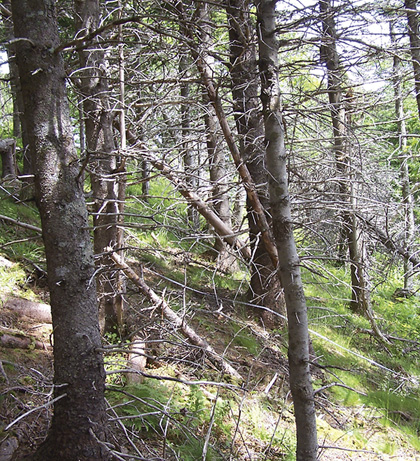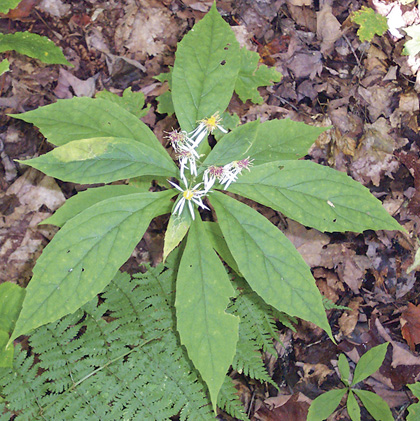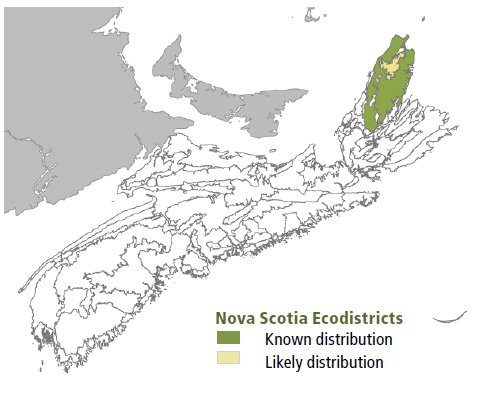
Forest Vegetation types - HL2
HL2 — White spruce / Wood aster
Picea glauca / Aster acuminatus
 |
Otter Brook, Inverness County |
Concept: This early to mid-successional Vegetation Type (VT) features abundant white spruce with lesser balsam fir. Understory layers are usually poorly developed with needle carpet forest floors. Conditions that encourage the establishment and renewal of this VT are not well understood, but farmland abandonment is not considered a requirement, despite obvious canopy similarities between this VT and OF1 (White spruce / Aster – Goldenrod / Shaggy moss). White spruce / Wood aster is found scattered throughout the Cape Breton Highlands.
Vegetation:White spruce is the dominant overstory tree, with a component of balsam fir. Yellow birch is a common associate often with white birch, heart-leaf birch and/or red maple. The poorly-developed shrub layer consists mainly of regenerating trees and mountain-ash. Herb layer diversity and abundance are low; only evergreen wood fern and wood aster are common. Species associated with drier sites may also be present including hay-scented fern, drooping wood sedge and fibrous-root sedge. The bryophyte layer is poorly developed, but usually includes small patches of mainly hypnum moss and broom moss interspersed with needle carpet.
Environmental Setting: HL2 is mainly associated with fresh, nutrient medium soils derived from glacial till and/or colluvium deposits. This VT is found scattered throughout the Cape Breton Taiga ecoregion and Cape Breton Highlands ecodistrict, primarily on steep upper and middle slope positions. Wind and exposure significantly limit tree growth. This relatively uncommon VT is scattered through parts of northern New Brunswick and the southern boreal region of Quebec.
Successional Dynamics:HL2 is an even-aged, early to mid-successional VT dominated by white spruce. Besides harvesting, the main stand-level disturbance agents are insect infestation and windthrow. White spruce is somewhat resistant to spruce budworm defoliation, but secondary infestation by bark beetles could cause significant tree mortality. Suitable seedbeds for white spruce regeneration may arise when disturbed sites are re-vegetated by graminoid (grass-type) species (resulting in similar conditions as old field sites). White spruce stand development can also be encouraged by moose browsing (an important successional driver in the highlands) which reduces the presence of more palatable species like balsam fir and various hardwoods, which in turn gives the white spruce more opportunity to establish and thrive. Mid to late successional stages of HL2 may include HL1a (Balsam fir / Mountain-ash / Large-leaved goldenrod variant White birch / Wood sorrel) and HL4 (Birch / Wood fern – Wood sorrel). When found on steep, upper slope and crest positions Succession to TH1 (Sugar maple / Hay-scented fern) or TH6 (Red oak – Yellow birch / Striped maple) may also be possible.
Ecological Features: This small to large patch forest is primarily associated with the Maritime Boreal Cape Breton plateau. The ecosystem's longevity is a function of either natural tree senescence (approximately 75-150 years) or the frequency of spruce budworm epidemics. These forest patches may survive budworm outbreaks and provide important remnants of mature forest on the highland landscape. Stands with closed canopies provide shelter for wildlife in winter. White spruce seeds are eaten by crossbills and finches, while small mammals both eat and cache white spruce seeds and cones.
 |
| Wood Aster |
Distinguishing Features: This white spruce dominated softwood forest is described for the Cape Breton Highland plateau and its upper slopes. Shrubs, herbs and mosses are poorly expressed. A needle carpet is common.
| Slope Position: | Middle5 Upper5 |
Surface Stoniness: |
(Non - Slightly)5 (Very - Excessively)5 |
Bedrock Outcrop: |
(Non-rocky)10 |
Elevation Range: |
246 - 324m |
Slope Gradient: |
Steep5 nd5 |
Aspect: |
South10 |
Exposure: |
Exposed10 |
Microtopography: |
Level10 |
Drainage: |
Well5 Rapid5 |
Soil Type: |
ST210 |
Parent Material: |
Glacial till5 Colluvium5 |
Rooting Depth (cm): |
(30-45)5 (>45)5 |
Duff Thickness (cm): |
(6-10)10 |

